Introduction to Nutrition Planning App Development

If you plan to create a diet planner app or website that will attract and engage audiences with a variety of valuable features, here you can find professional tips based on Alternative-spaces’s experience developing JSA, a web and mobile fitness application, and Stridist, a web platform for fitness and nutrition businesses.
Table of contents
- Why Is It High Time for Nutrition Planning App Development?
- Ideas for Nutrition Planner App Development
- Key Features of a Diet and Nutrition Mobile App or Website
- How to Build a Diet & Nutrition Planner App – Alternative-spaces’s Advice
- Alternative-spaces’s Experience in Nutrition Planner App Development
- How Much Does It Cost to Build a Diet & Nutrition Planning App?
On the one hand, technology is making our lives easier. Various web and mobile apps help people study, buy groceries, and even access healthcare and dentistry services from the comfort of their homes. VR technology makes it possible to meet colleagues and collaborate remotely, have a movie night, or visit an art gallery while sitting on one’s couch.
On the other hand, these developments also contribute to an increasingly sedentary lifestyle that can lead to health and psychological problems. Urban stress makes it more difficult to maintain a work-life balance with proper nutrition and regular workouts.
Luckily, technology can also offer solutions for these challenges, e.g., through mental health, fitness, and diet planning app development. Users can choose from a variety of fitness websites and mobile apps, mental health apps, walk and run tracking apps, and even VR and AR games and experiences promoting fitness and mental well-being.
This article is dedicated to diet and nutrition apps that help users lose or gain weight by following a proper diet and keeping tabs on their calorie intake. If you’re contemplating one, here you can find a complete guide on how to build a nutrition planning website or mobile app.
Why Is It High Time for Nutrition Planning App Development?
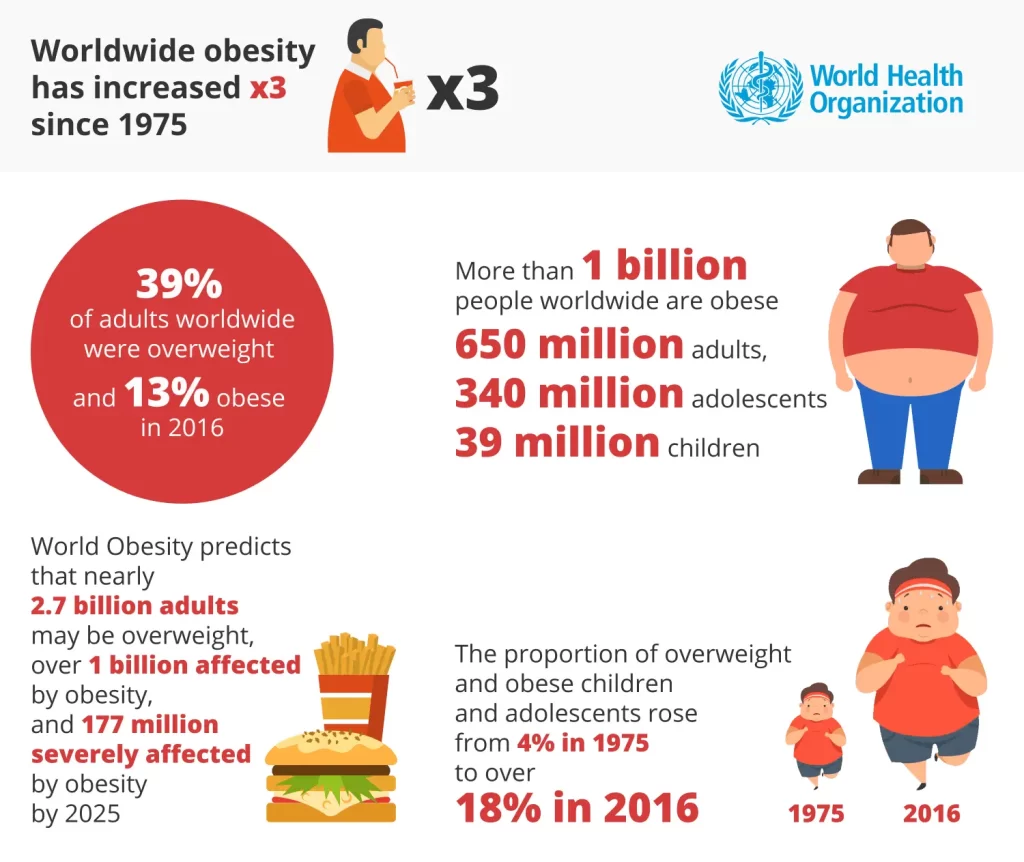
These alarming stats translate into immense opportunities for diet planner app development, and the apps’ target audiences (TA) are not limited to overweight people. Many groups need assistance with their diets, such as patients with diabetes, eating disorders, etc., pregnant women, athletes, and others. Products that provide information and help track specific dietary requirements are becoming increasingly popular. Moreover, healthy lifestyle and nutrition are global trends, so a handy app will appeal to anyone interested in healthy eating.

The growing penetration of mobile apps has facilitated an increasing demand for diet and nutrition apps. These apps are also becoming increasingly popular among mobile app users.
Diet and nutrition tracking has been instrumental in the nutrition app market development so far, and functionalities like product scanners, calorie, macro- and micronutrients, and activity tracking are expected to further its growth. The growing focus on dietary restrictions has caused a surge of diet-specific apps.
The growing competition among key market players and demand for greater functionalities is expected to increase the cost of nutrition and diet planner app development in the coming years. While the moment is propitious, entrepreneurs that invest in health, nutrition, and fitness apps now may become leaders and make a fortune.
Ideas for Nutrition Planner App Development
The market offers a variety of nutrition-related apps that can be classified by:
- their primary goal and functionality, such as calorie counters, nutrition planners, diet trackers, online marketplaces, or platforms that connect users and nutrition experts;
- niche, e.g., nutrition apps for bodybuilders, pregnant women, vegans, and others.
It’s more practical to develop a diet assistant app or website catering to multiple categories. There has also been a hike in demand for apps with multiple functionalities as users seek one-stop solutions for all their fitness-related needs.
However, with a limited budget, it’s OK to start with a minimum viable product (MVP), a minimal set of features addressing one issue. Once the MVP gains traction and builds trust among users, you may expand its scope and service catalog.
Here are several ideas for nutrition planning app development that you can realize as a specialized app, combine, enrich with your unique solutions, adapt to your specific market, and so forth.
Meal planning
Users may enter their current and desired weight, diet, food preferences, allergies, etc., into the app and it will suggest a diet chart for a day, week, or month according to the user’s needs.
For example, Eat This Much provides personalized meal plans based on a user’s preferences, budget, and schedule and offers a database of healthy recipes that can easily become grocery orders thanks to integration with Instacart and AmazonFresh. Grocery lists automatically update when users review their weekly meals, etc. Users can enter the food they already have in the fridge, and the app’s algorithms will use it up with priority. The app also includes a calorie calculator.
Professional platform
These apps connect users with nutrition experts and coaches to help with specific goals like weight loss, muscle gain, health issues, etc.
Usually, a consumer browses the app’s database to find a suitable professional. Then, they’d schedule an appointment during which the health and fitness expert can analyze the client’s current situation and goals and suggest improvements.
Professionals can provide users with personalized meal plans, recipes, and tips, educate, guide them through a diet regime, track their progress, and even generate reports using nutrition tracking tools. The feature set may include a search engine with multiple filters, a calendar, chat, video conferencing for virtual diet consultations, online classes, and online payment functionality.
Read also: How to develop a doctor appointment booking system?
Healthy food online shop or marketplace
The app owner can use this diet and nutrition app to sell their own goods, as an online expansion of a physical stores chain, or generate revenue as an online marketplace. They can sell healthy and organic foods, health supplements, and meals. An integrated shipping service will enable prompt delivery of healthy meals and groceries.
For example, HappyCow is a vegan diet-focused online marketplace app.
These apps can also include a meal planning feature, e.g., as a set of questions that, once answered, will help the app display or recommend the most relevant foods or meals. For example, it may be helpful to ask about the visitor’s goals for using your app: weight control, weight loss, muscle gain, etc.
Read also: Why and how to build a grocery app?
Diet monitoring app
The primary function of these apps is to count calories. They can record the food a user consumes, daily water consumption, or the number of calories absorbed and burnt. Visualization of the data in an easy-to-understand way is a good user experience.
Users can enter the amounts of calories manually or scan packaged food items with an in-app barcode scanner before or after a meal. The calorie monitoring tool can also fetch information on calorie intake from a native or third-party meal database or an activity tracker, e.g., the number of steps a user walked or other activities.
The logged data allows seeing trends to understand whether the user is taking an appropriate number of calories and nutrients. It can also help suggest dietary or fitness program recommendations from a comprehensive database.
Fooducate, Lifesum, Lose It!, and MyFitnessPal are all diet and exercise tracking apps that also come with meal planning, recipes, marketplaces, workout libraries, and other helpful features.
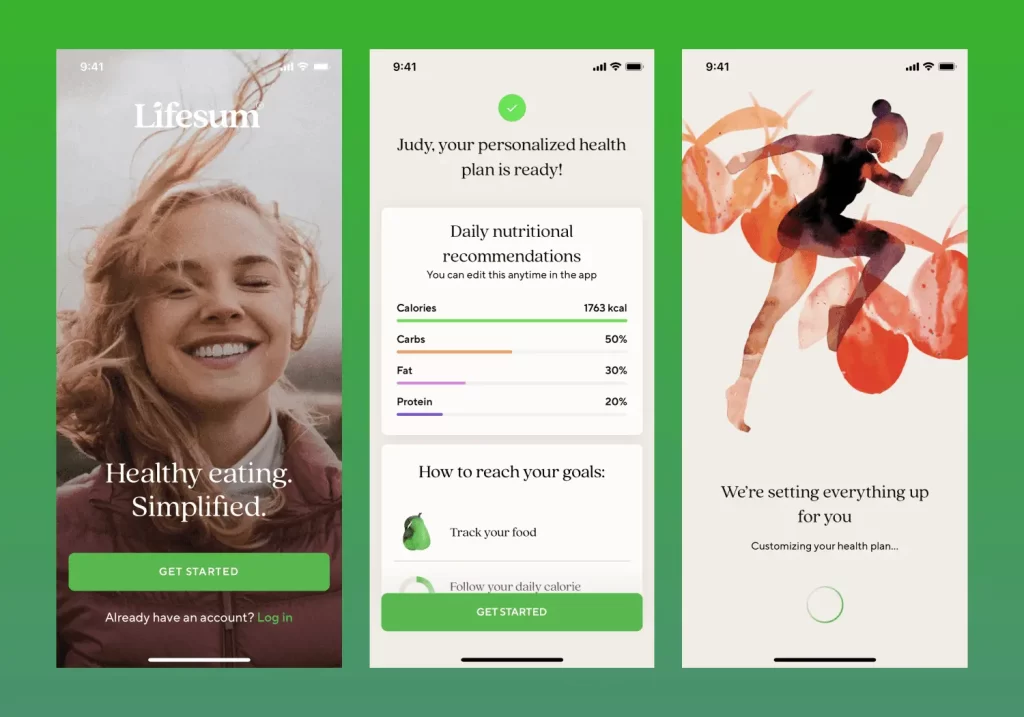
Wager app
Wager apps combine diet challenges with betting, further motivating users to reach their fitness goals. A user bets some money that they will achieve a specific weight goal. If they lose the required number of stones by a specified date, they get their money back or win a cash prize. If they fail, they lose the money.
DietBet is an online weight loss game with cash prizes. The app claims that an astounding 96% of players lose weight. For reliable weight verification, the app developed a two-photo validation process. When a player submits an official weigh-in, they receive a time-specific “weigh-in word” they must write down on a piece of paper. Then, they take two photos: one full-length photo of their person standing on the scale, and another of the scale’s readout with the piece of paper. Then, DietBet referees individually review each weigh-in submission. The payout amount depends on the size of the pot and the number of winners in a game.
It’s also helpful to know how various nutrition and diet apps earn money for their owners. The niche offers a variety of monetization methods:
In-app advertising
A nutrition or diet website or mobile app with a considerable user base can generate corresponding revenue through advertising. The key to success is to display ads relevant to the users’ needs and to make them unobtrusive. For example, you can display ads that promote food supplements, health-related events, sportswear, equipment, etc., as banners or as “native ads” incorporated in blog posts or other content.
Freemium model
This model attracts users by making an app’s basic functionality available for free and then offering paid access to advanced features and exclusive content. The key is to have a considerable part of the audience so interested in the premium version of your application that they are ready to pay for it. The freemium model can also be combined with other monetization methods.
Subscription / paid membership model
This model is one of the best ways to monetize a diet and nutrition app. If users are totally satisfied with or even become addicted to an app during a free trial period, they will likely convert into paying members afterward. For example, JSA users have seven days after registration to test the app; if they like it, they buy a subscription or month block. Constantly improving the app’s service catalog and offering several subscription plans and regular discounts, an app developer can nurture a loyal paying customer base and secure a steady revenue stream.
Pay to download
This monetization model implies paying for an application only once. To convince consumers to pay the price indicated on the app’s Google Play or the App Store page, you need either a massive promotional campaign or to develop a product that people won’t be able to give up after a short trial.
Ecommerce
An online store or marketplace can provide a source of revenue through sales or a percentage from each transaction. It’s key to provide a customer experience and payment process that is on par or better than at major online stores.
Transaction fees
A platform that connects online dietitians, nutritionists, or fitness trainers with clients can charge a percentage of the transactions and fees for the listings.
Read also: How to build an online fitness marketplace
Sponsorships
A nutrition and diet app owner can form partnerships with relevant brands to place their logos on interfaces, publish sponsored content, and organize weight loss challenges with prizes from sponsors.
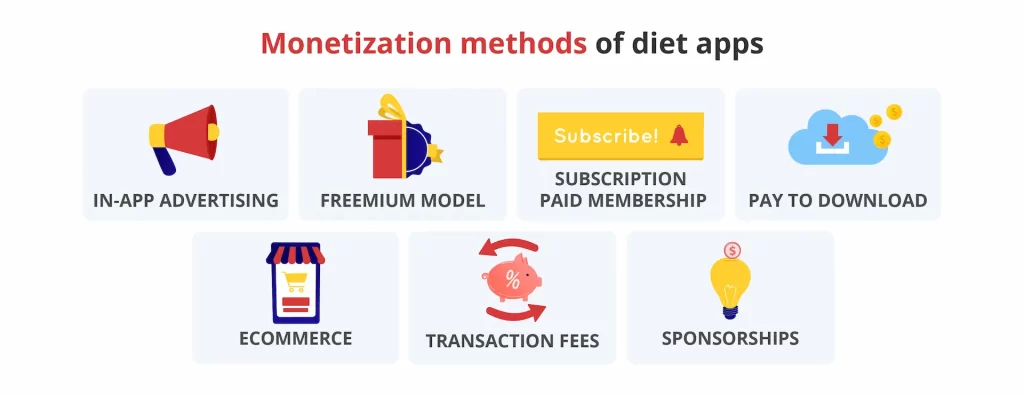
Finally, a diet or nutrition app may be developed not for direct monetary benefits but as an instrument of brand promotion or support for offline activities.
Depending on your goals, the type of your diet and nutrition application, and your preferred monetization strategy, the app can have several types of users, such as regular users/consumers, nutrition experts, vendors, admins, etc. The following chapter should give you an idea of the consumer features you may need to include in your app.
Key Features of a Diet and Nutrition Mobile App or Website
Registration
The registration process not only initiates the creation of a user account but also promotes personalization. The system needs to know a user’s age, gender, height, weight, goals, food allergies, and other health indicators and preferences to provide the most value. However, make sure not to ask users too many questions during the registration. The app should facilitate easy sign-up manually, using the email or phone number, or via their social media profile (like Facebook or Twitter).
Diet planning apps are not essentially healthcare apps, but the GDPR and other regulations can be rather strict. It’s a good practice to store as little personal data as possible and to be cautious when working with it. A secure authorization process should ensure that the users’ data isn’t lost or compromised if they lose or change their device or reinstall your mobile app.
Goals
This feature should enable the user to set a goal of using your diet and nutrition app and then monitor their progress. The app may mark and celebrate users’ micro-achievements and completion of the goals to help them stay positive.
Macro-calculator
The app may help users calculate the amounts of calories, proteins, carbs, and fat they need daily based on their shape, age, lifestyle, and particular needs.
Food logging and calorie tracking
This feature is essential for persons trying to increase, decrease, or control their weight. They can track their calorie intake by entering the type and amount of food they are about to eat or have eaten. The app will display the respective number of calories and, if needed, determine whether the user has consumed the required daily amount and even provide recommendations.
Barcode scanner
A barcode scanner embedded in a diet mobile app will facilitate calorie tracking as an alternative to manual food logging and assist consumers when they shop. Packaged food products typically come with a barcode that consumers can scan using their smartphones to fetch accurate nutrition information, such as calories and ingredients.
Physical activity tracking
Although this optional feature isn’t directly related to nutrition, it can be valuable to audiences that need to see the difference between burnt and consumed calories. This will help them evaluate the dynamics and change their meal or workout plans if needed.
This functionality will require integration with fitness trackers and wearable devices that automatically and accurately record physical activity data, such as steps, sleeping, pulse, heart rate, blood pressure, etc. This data will be transferred to the diet planner app to analyze and consider when recommending meal plans, tracking and visualizing progress, etc.
The developers must ensure a seamless connection between the nutrition app and wearables like Apple Watch, Fitbit, Mi Smart Band, or less popular devices. It may be reasonable to cover as many options as possible to cater to wider audiences. Make sure the team has adequate experience in building similar applications.
Hydration tracking
The logic of this optional but valuable feature may include a calculator to determine daily quantities of water for each user based on their parameters (height, weight, and age) and a water consumption tracker. The optimal water intake may be visualized by several glasses or a bottle gradually filling up as the user enters their consumption of water and other liquids.
The feature will be most beneficial as a “remind & control” function of a mobile app. The app can also provide analytics and offer recommendations, e.g., regarding the combination of certain foods with liquids like coffee or soft drinks.
Dashboard
The dashboard may provide an overview of the user’s daily/weekly calorie and nutrient intake and other essential key performance indicators (KPIs), the user’s progress toward their fitness goals, the current meal plan, recommended foods, nutrition tips, and more. The dashboard should be customizable, e.g., so it can present specific KPIs and other information most relevant for a particular user in the most convenient way.
Diet plans
To get started, the app can offer a list of popular diet plans classified by goals and restrictions (e.g., vegan, gluten-free, etc.) for the user to browse, select, and follow. Ideally, the app should employ artificial intelligence and machine learning to recommend or generate a health and diet plan for each user according to their goals and considering data like body type, preferred foods, lifestyle, geographical location, health issues, etc.
Alternative-spaces implemented a meal plan generator using a consumer’s goals and data in JSA and another fitness app for the same client.

The more personalized experience you can offer, the better. If users have a dietitian’s or doctor’s prescription, it would be useful to enable them to manage their diet plans accordingly. Users may also appreciate functions for food supplement intake.
Alternatively, or as an add-on, the app may offer live private professional consultations. During an online meeting, a nutrition expert can modify the user’s selected diet plan, create a custom plan, and provide valuable tips. This can become your USP.
Rating and reviews reflecting other users’ experience with a particular meal plan will help users make better decisions and improve the overall app experience.
Recipe database
For many people, cooking is the most challenging part of healthy eating. A book of fast-to-cook or pre-made healthy recipes will not only motivate and help users to cook healthy meals faster but also encourage them to open your app more frequently.
Ideally, there should be thousands of recipes. Implement an effective search by title, ingredients, etc., and rich filtering options.
The format of recipes can be limited to plain text, include photos, or even provide step-by-step voice or video instructions. You may offer author recipes from celebrities, chiefs, nutritionists, or other influencers as your USP, but the creation and manual uploading of such massive content will take considerable time and effort. Alternatively, an integration with a third-party database will enable instant access to thousands of recipes. You can also encourage users to add and share their recipes on your platform.
Chatbot
A chatbot may prove effective at recommending meal plans, recipes, and foods, scheduling appointments with professionals, answering frequently asked questions, and other tasks.
Shopping list
When a user selects a weekly meal plan or a recipe, the app may automatically import the respective foods and ingredients to the shopping list or the shopping cart if your app includes ecommerce functionality. Users should be able to delete and add goods manually as well.
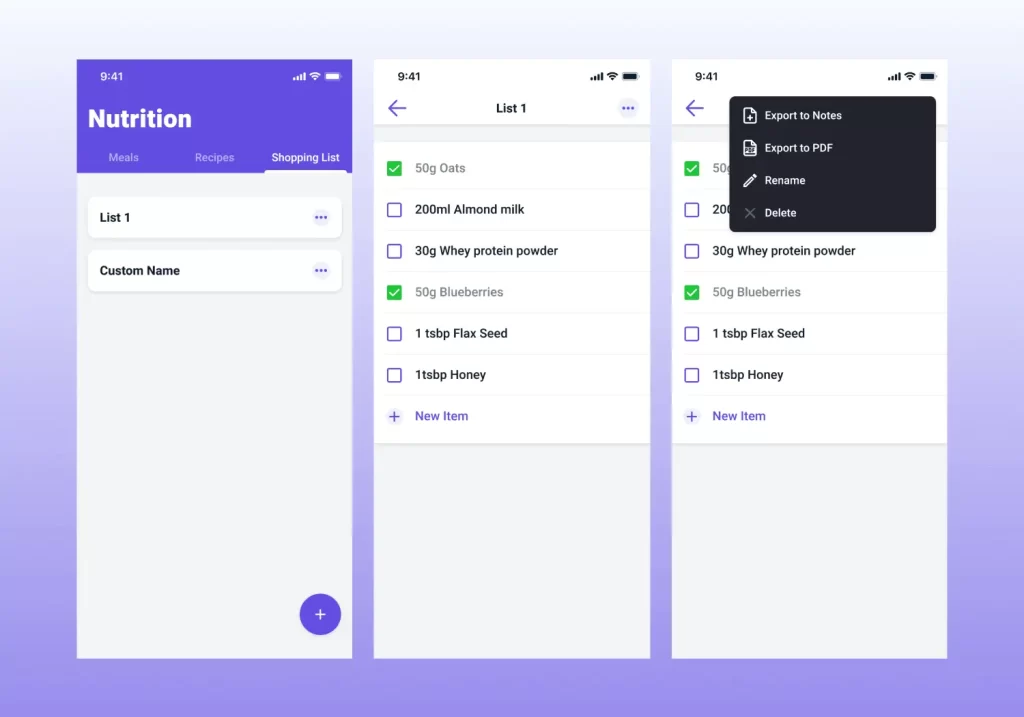
A shopping list not connected to online shopping can help users shop at physical stores faster and easier, but a shopping list functionality directly linked to diet plans and healthy recipes is even more valuable and can benefit the diet and nutrition app owner financially.
Purchases history and templates will help with further shopping.
Online shopping
The app may include a store where users can buy healthy foods and nutritional supplements or a whole marketplace where trusted vendors sell nutrition-related goods. The meal plans, recipes, and healthy food recommendations offered by the app can be connected to vendors, enabling faster shopping for consumers and commissions for the app owner.
The required functionalities include a browser with many filter options and the ability to visit a vendor’s page, see a store’s rating and reviews, compare prices, place an order, and pay for it.
Read also: How to Build an eCommerce Website
Push notifications
Suppose your diet planner is a mobile application. In that case, notifications and alerts won’t let users miss their meal time, calorie intake logging, a glass of water, consultation, workout session, or other important health-related tasks. The app can also:
- deliver motivational messages to inspire users to continue their diet;
- send “Have a great day” notifications to improve user engagement;
- inform users about new app features;
- send personalized recommendations and offers, etc.
However, don’t overuse the functionality so notifications don’t become annoying.
Professional consultations
This feature targets consumers that seek professional help with weight loss/gain or other goals and are ready to pay for a more personalized app experience.
The professionals should be able to provide consultations through an in-app chat or video calls, access a client’s medical files, create and share diet plans, recipes, tutorials, and other content, track their client’s progress, and more.
Be ready to build a personal nutritionist app, i.e. a separate registration and verification flow for the professionals and an interface enabling them to provide the required services and receive payments. You also need a selection and qualification authentication process in place, which can include personal interviews via the app, uploading certificates and other documents, etc.
Blog/educational section
This optional section can be valuable both for newcomers interested in healthy eating habits and for more sophisticated audiences that appreciate industry news, recent research, etc. This will improve the overall app experience and increase user engagement. Moreover, if people enjoy the content, they will likely share it on social media, spreading the word about the app.
You can also monetize this feature by offering free content to all users but restricting exclusive content from guest experts, celebrities, and partners to premium members.
Community
Users may appreciate communication with peers who are on the same journey because they can provide support and advice, as well as an opportunity to share their experiences and achievements. In-app forums or blogs can help meet this need.
Social sharing
Users may like sharing recipes, blogs, nutritionists’ contact details, or the entire diet and nutrition app with family, friends, and colleagues. By spreading the word, they are expanding your potential audience.
Help and assistance section
The help and advice section can include FAQs, video tutorials, or even a chat with the support team.
Feedback
User feedback is invaluable for app developers as it helps improve the app experience, increasing customer retention and the competitive edge. App users should be able to evaluate the app’s features and post complaints and requests for more features.
Logical connections between the app’s features, e.g., meal plan – recipes – shopping cart, will increase both user satisfaction and your profit. The system should be built with scalability and flexibility in mind so it can be easy to modify according to changing user needs and accommodate new functionalities, monetization methods, and new categories and increasing numbers of users in the future.
How to Build a Diet & Nutrition Planner App – Alternative-spaces’s Advice
1. Conduct proper research and discovery.
Firstly, you need to identify the group or groups of customers to target. For example, do you want to cater to all people who want to develop healthy eating habits, or are you ready to tailor your app to senior citizens, children, or diabetic, anorexic, or other patients?
Analyze the TA’s needs and problems. For instance, if you target nutritionists, gym trainers, or other fitness industry professionals, figure out the ways to bring value to them.
Research the market and competitors. Explore the rivals’ diet applications to identify their best features and drawbacks and understand the best practices in nutrition planning app development and design.
The knowledge of the end-user’s needs, goals, and preferences will enable you to determine and prioritize the features of your diet planner app. Their age, education and income levels, cultural specifics, or special needs should inform your decisions when you choose the platform or platforms for the app, its visual style, content, monetization methods, etc.
For example, mobile technology facilitates the use of reminders and alerts. You can cover a wider audience by making a diet application for Android devices first.
Involve experts as early as possible in the product development. Flaws in the app’s logic and algorithms may result in a bad customer experience or even affect the users’ well-being. All calculations and recommendations in your app must be based on scientific data and professional nutritionist expertise. So, you need to engage:
- certified dietitians or at least nutritionists or fitness coaches;
- software engineers with a track record of similar application development.
Alternative-spaces’s experts nearly always advise clients to ‘start small,’ i.e. to build an MVP with the core diet planning features plus something that will set it apart from the competition. The lean development approach works best if you want to enter the market faster, have a limited budget, or are not sure that your original solution will hit the product-market fit.
Choosing the right scope of features is tricky. If your website’s feature set falls short of a competitor’s experience, it may fail to attract users. If your mobile app is too complicated, you may end up wasting money and time on developing something that nobody wants to use.
It’s wise to split nutrition planning app features into two categories: functions that fit the MVP scope and nice-to-have features that you can implement after receiving early adopters’ feedback and pitching your project to investors to support scaling.
In any case, you should have at least a project requirements document at the end of this phase. It will facilitate the consequent steps: the search for app developers, product design, and proper diet planner app development.
2. Assemble a team of experienced app developers.
The product development team’s size, lineup, and qualifications may depend on the project scope, timeframe, and budget. For example, a diet planning website development will likely require at least one:
- User experience (UX) and user interface (UI) designer
- Frontend developer
- Backend developer
- Quality assurance (QA) specialist
- DevOps engineer (if necessary)
- Project manager (PM)
A diet mobile app development team may include:
- Mobile app designer
- Android developer and/or iOS developer
- Backend developer
- QA engineer
- DevOps
- PM
Alternative-spaces’s recommended technology stack for diet planning app development includes, but is not limited to:
- Frontend – React for a website and React Native for mobile app development
- Backend – Python or NodeJS
- Database – PostgreSQL or MongoDB
The programmers’ level should be at least Middle in small teams like these. If you need to complete numerous features by a specific deadline, you can increase the number of specialists.
Suppose you do not have the required expertise in-house. In that case, you can delegate the task to external developers who have worked on similar projects and know all ins and outs of regulatory compliance, integration with wearables and third-party APIs, and other technicalities. Outsourcing may also help you save up to 50% of your project budget.
3. Prototype and create the UX/UI design to help and engage users.
Prototyping allows for verifying design ideas and checking whether the features will work as intended without coding. Simultaneously, the designer will develop your app’s color scheme, style, and original brand elements.
The look-and-feel of a diet and nutrition app is a major deciding factor. It must be adapted to the TA’s needs, establish credibility and trust through every element, and be more user-friendly, convenient, and attractive than the competitors’ applications. It must be easy to navigate all of the app’s features and access the tools and resources with minimal scrolling and clicks.
UX/UI standards for nutrition planner app development imply minimalism and simplicity combined with vivid images. There are distinct design patterns for such websites and apps, and it’s reasonable to follow them; an experienced designer will be an invaluable asset to your project.

Simultaneously, original elements like gamification or cute animated “assistants” can help establish an emotional connection with the users and distinguish your app from the competition.
4. Have your diet and nutrition website and/or mobile apps built and tested.
At this stage, the web and mobile developers must implement the designed features while the backend developers build databases and implement APIs, services, and libraries for the system’s inner workings. For example, food logging and calorie tracking require the system to instantly access accurate information about the number of calories and nutrients in each food, product, or meal. APIs will enable your app’s integration with relevant third-party databases.
Alternative-spaces recommends an incremental development approach, starting with a minimum of core features and further building up the app based on user feedback. The software also must continuously go through
- functional testing
- usability testing
- interface testing
- performance testing
- security testing
The mobile app must run equally well on different devices and be synchronized with the web version of your diet and nutrition service.
Alternative-spaces’s Experience in Nutrition Planner App Development
James Smith Academy (JSA) is a web and mobile fitness application that enables users to receive a personal workout and nutrition plan and support from a live coach and compete with other users in weight loss challenges.
Alternative-spaces’s cooperation with the company began three years ago with a UX/UI audit that resulted in a complete redesign of their existing application and identity. The designer in charge went to the gym and played sports using James Smith’s advice and application to understand its issues and figure out optimal solutions.
Soon, JSA hired Alternative-spaces’s specialists to work on all aspects of the project. We offered both the necessary human resources and ideas for improvements to the product. The work included modifications and enhancements of existing features, new functionality implementation, several design updates, changes to the membership plans and subscriptions, redesigning the coaches’ admin panel, and continuous bug fixing.
Over three years, the company has grown its user base to over 100K users. Some of the features that engage these users are:
- Personalized programs. A user can request a custom training program from a coach registered in the application. A free coach will prepare a program tailored to the user’s needs based on the information collected during onboarding, such as age, gender, fitness goals, etc. The coach can chat with the user to clarify the details.
- Meal generator. Users can generate a meal plan based on their goals, preferences, and data submitted during onboarding. Alternative-spaces’s team created an API for this purpose.
- Momentum score. Fitness devices synchronize the user’s data with the app, which will display it in the momentum score section. The team implemented an API enabling users to log into their account via the web version and connect their devices there.

Initially, the designer used Sketch for design and InVision for prototyping. However, when Figma gained momentum, the designer shifted to this multi-purpose instrument. The designer uses Adobe products, such as Illustrator and After Effects, for illustrations and animations.
Currently, after a third-party UI/UX audit, we continue working on:
- a new design
- new onboarding flow
- new functionality for workouts
- new flow for challenges
- Learn page update
The team is also researching a new nutrition tracking service that would enable users to keep tabs on the consumed calories and carbs, sugar, fiber, protein, fat, saturated fat, and sodium.
Alternative-spaces also built a comprehensive business management web platform for fitness and nutrition professionals. Stridist empowers these customers to run their businesses and provide their services online in one easy-to-use digital place. The platform’s best features include:
- An intuitive workout builder for personalized coaching experiences
- Effortless client management and progress tracking
- A convenient dashboard with client filtering
- Secure payments
- All-in-one solution that meets the consumers’ training and nutrition goals
- Ability to keep in touch with a coach every day
- Easy-to-see training and nutrition data at their fingertips
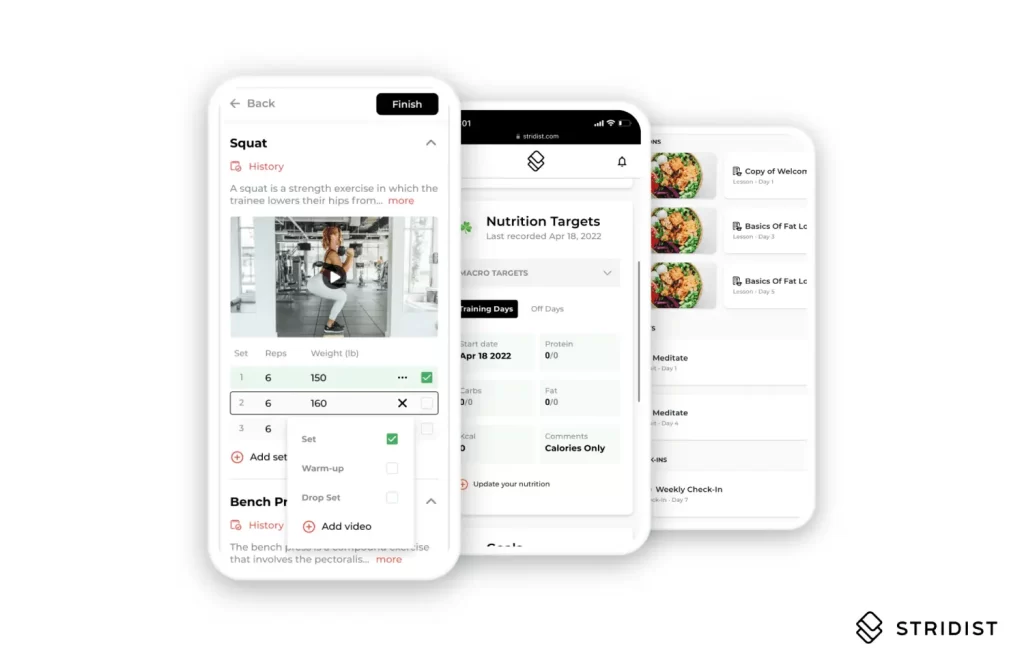
Stridist users retain clients for 11 months longer than industry standards and often add up to $2K of extra revenue per client per year.
However, when Stridist first approached Alternative-spaces, their fitness website faced serious product operation and scalability problems. They needed a product development team to solve those issues, update the product’s functionality, and ensure proper platform performance.
Alternative-spaces involved its best-in-class specialists in gathering project requirements and designing and developing a well-structured website according to them. Namely, Alternative-spaces’s specialists are responsible for the following improvements:
- Due to the existing website architecture’s issues with agility and scalability, platform operation, and user experience, the team prioritized the project’s migration to a new architecture. They built it using Amazon ECS clusters that help guarantee high-quality product operation, enhance its capacity, and significantly broaden functionality.
- Alternative-spaces’s team developed an easy-to-use editor that allows fitness coaches to quickly create gym or home workouts, exercise demo videos, or full follow-along workout videos. Saved program templates automate the program creation process.
- The added ability to sort and filter clients by name, due date, and tag significantly simplifies navigation for coaches.
- We added a step counter, nutrition targets, goals, and progress photos on the client profile page. This helps nutritionists and fitness coaches track their clients’ results, assess their training performance, and help them to achieve desired goals.
- Alternative-spaces’s specialists integrated the Stripe system, allowing users to send and accept payouts online securely. This helps automate the finance process and track payments within the platform.
- We streamlined the registration process by adding the ability to sign up with Google, link the coach card before registration, and choose one of the subscription plans.
The new website architecture and features helped extend the fitness business management platform without compromising performance.
The technology used to build Stridist included:
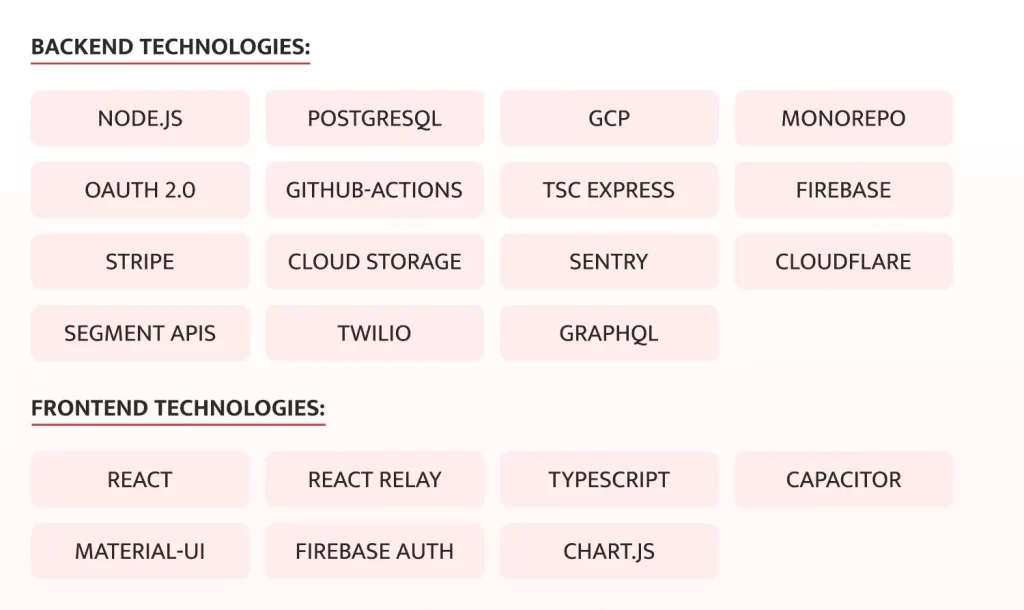
Thorough competitor research helped Alternative-spaces’s UX/UI designers to create efficient, user-friendly interfaces. Our specialists divided basic functionality into several logical parts and developed an intuitive interface that enables users to find the required feature easily and access them quickly. They made the UI design visually cohesive and clean but added bright color accents.
“We’ve had a fantastic experience working with the team at Alternative-spaces. They’ve delivered the vision we had for our platform. Communication has been great, they go the extra mile to make sure work is done to a high standard and delivered on time. It’s been a pleasure to have them on board. Highly recommend them.” – Sukh Sidhu, Stridist CEO
Hopefully, you have got the answers to most of your questions regarding nutrition planning app development by this time, except the final critical question.
How Much Does It Cost to Build a Diet & Nutrition Planning App?
A general formula can help you roughly calculate a nutrition planner app development cost: app development time X app developers’ hourly rate.
However, even these two variables are tricky to estimate because each application and business is unique. The factors that directly influence the cost include, but are not limited to:
- the app’s type
- the number of the desired features and their complexity
- for which platforms the app is being developed
- type of mobile application development (native, hybrid, or cross-platform);
- the choice of technologies and third-party services, such as payment gateways and feed providers
- the development team’s location
- the developers’ qualifications
- any deadline, etc.
The app’s type and complexity are the most significant factors determining its design requirements, technologies, software development and testing methods, and app development time.
On the other hand, if you choose to outsource your nutrition app development, you can reduce the budget dramatically. For example, here’s a breakdown of the approximate time required to build a diet planner mobile app:
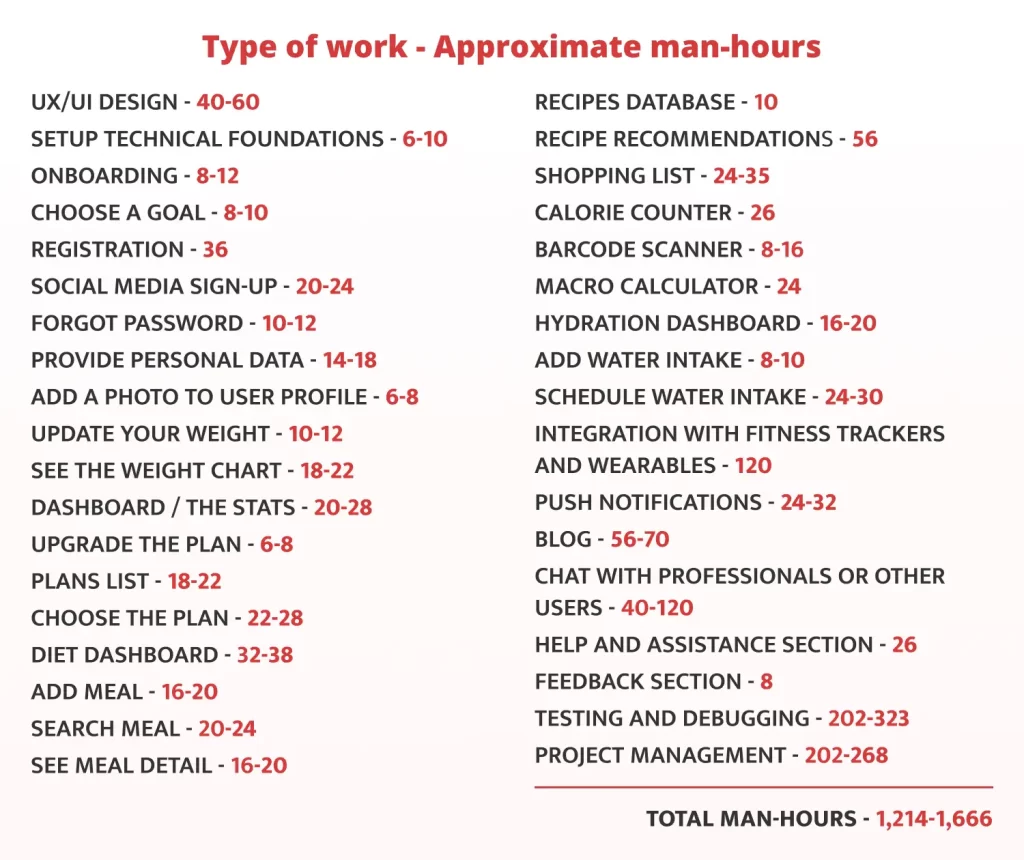
Multiplying this development time by the hourly rate of specialists in North America ($49-$210) leaves you with the approximate minimal price tag of around $157K. Suppose you outsource the app development to countries with a lower cost of living, such as Eastern Europe or the Indian subcontinent. In that case, you can negotiate lower rates and save up to half your budget.
For example, at Alternative-spaces’s rate of around $45/hour, the same project can cost around $55K-$75K to build. For a more accurate preliminary estimate of your product development, please feel free to contact Alternative-spaces’s experts right now.
Our company can build a custom food/nutrition app for you from scratch, improve your existing product, or provide the required specialists or an entire dedicated team for your ongoing project.
Alternative-spaces can cover all your needs pertaining to:
- product discovery
- proof of concept
- web and/or mobile app design
- web and/or mobile app development
- quality assurance, etc.
Content created by our partner, Onix-systems.
Source: https://onix-systems.com/blog/diet-planner-app-development Home
Home